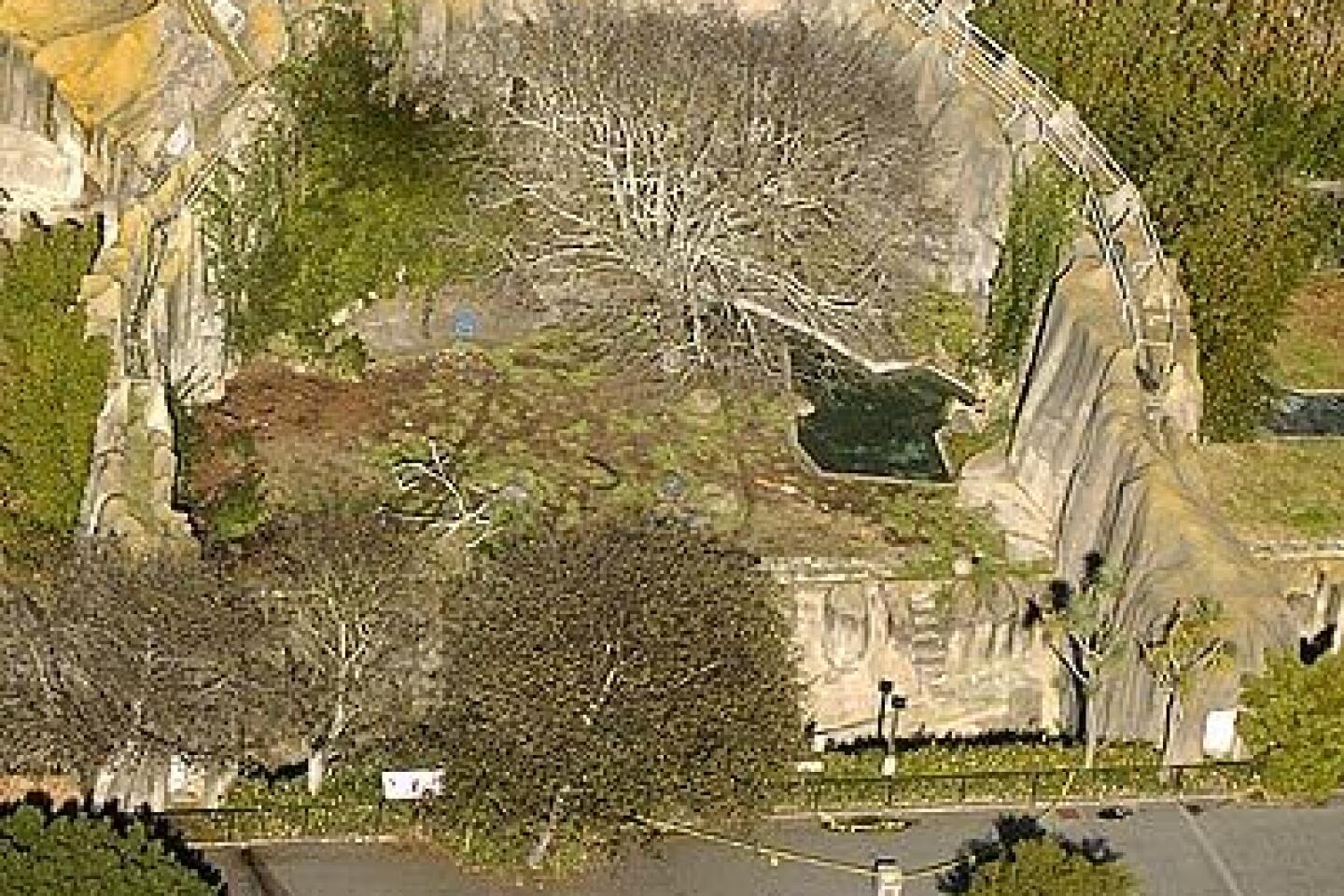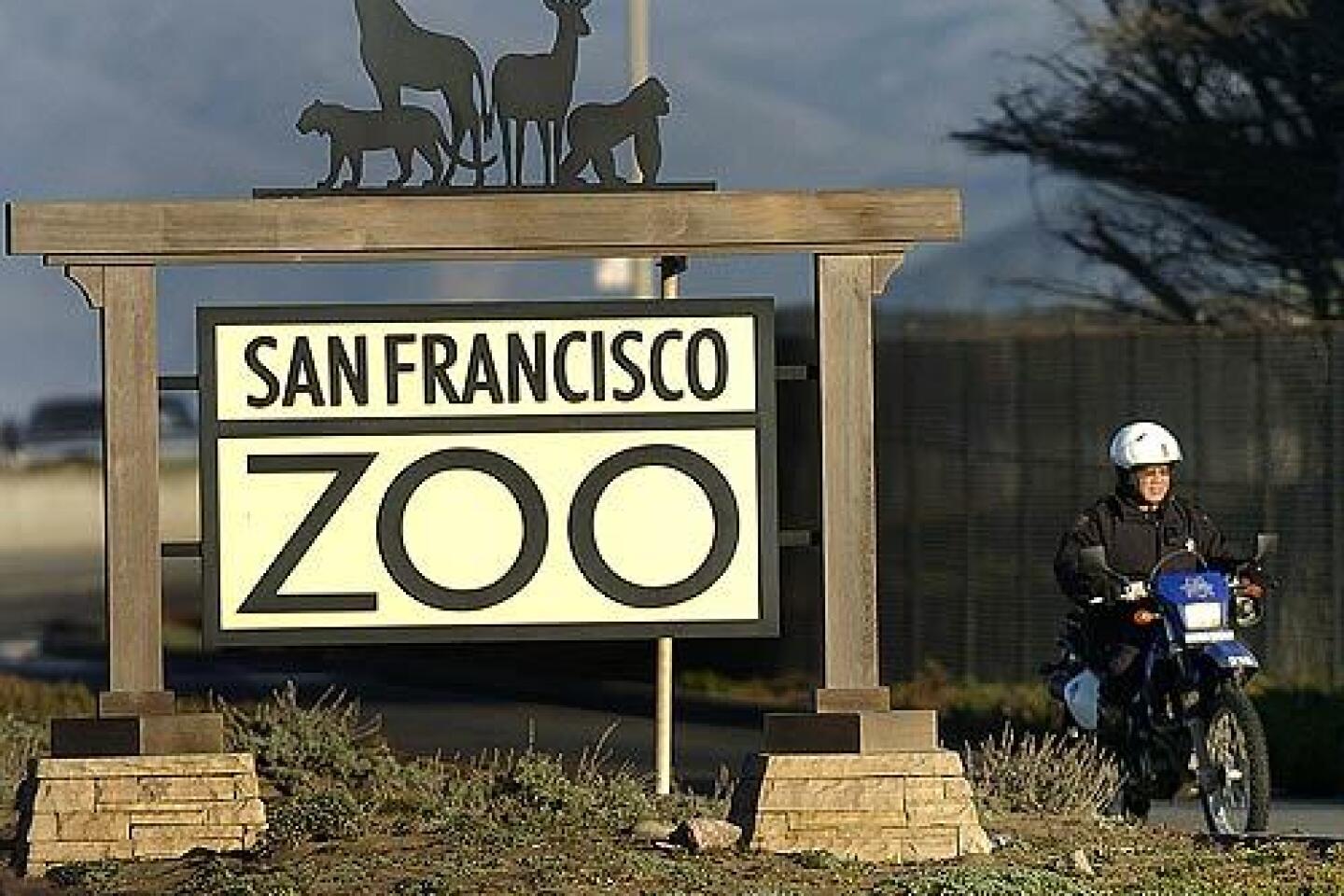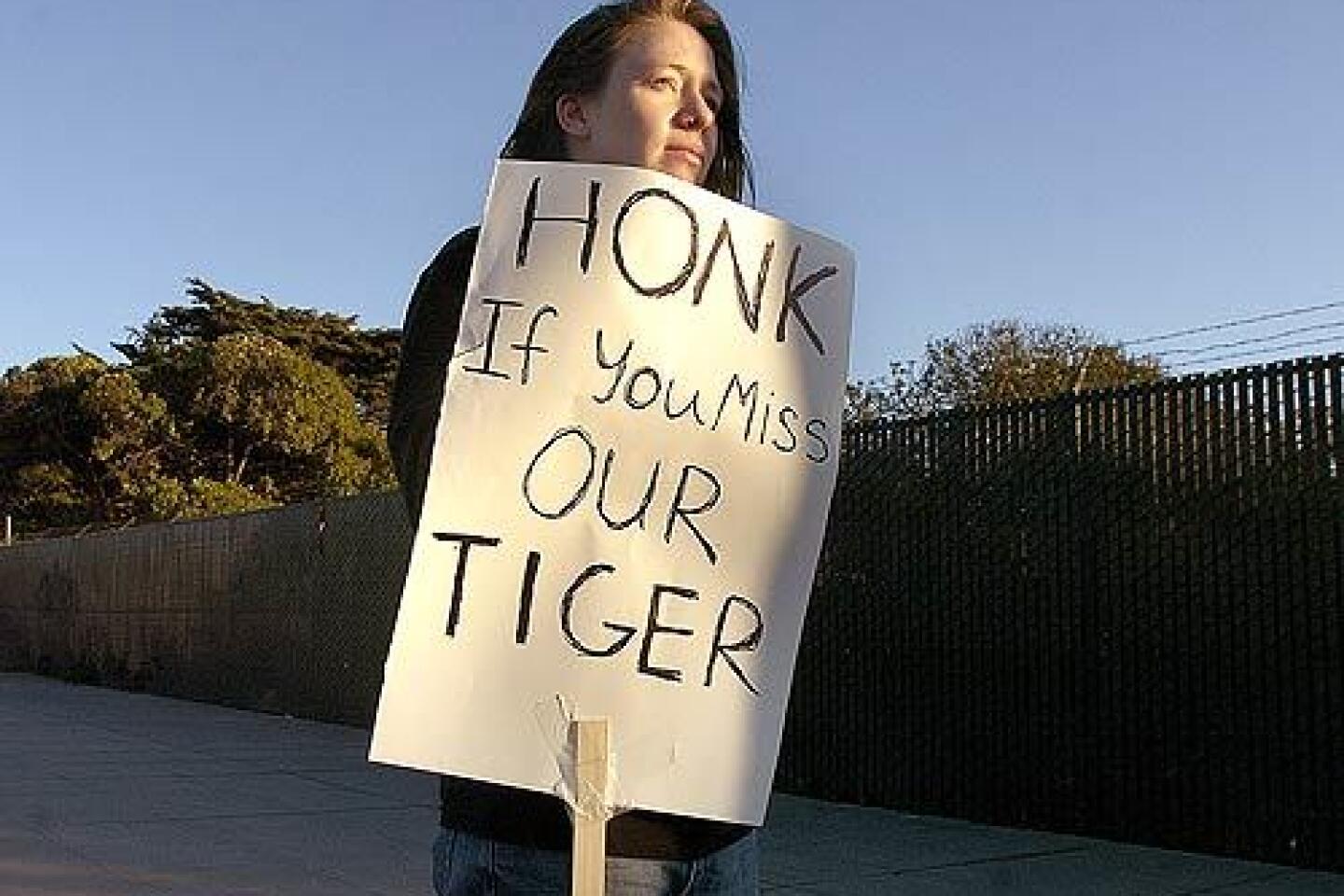Authorities unsure how tiger got out
- Share via
SAN FRANCISCO — The director of the San Francisco Zoo and the city’s police chief said Wednesday that they still didn’t know how a tiger managed to escape its enclosure on Christmas Day, mauling a teenager to death and seriously injuring two men.
At a news conference just outside the zoo property, Director Manuel Mollinedo said he would bring in outside experts to assess the safety of the outdoor enclosures for lions and tigers.
But Ron Tilson, a tiger expert who is the director of conservation at the Minnesota Zoo and author of a tiger husbandry manual, said the animal probably escaped through an open door.
“For over 200 years tigers have been kept in captivity in European zoos and for over 100 years in American zoos,” Tilson said. “No tiger has ever escaped from its enclosure . . . except by human error.”
Police Chief Heather Fong said the area had been declared a crime scene while the tiger’s means of escape was being investigated. The coroner’s office identified the dead teenager as Carlos Sousa Jr., 17, of San Jose.
Police killed the Siberian tiger, Tatiana, shortly after they arrived at the zoo Tuesday.
Asked why the animal was not put down after she attacked a zookeeper last year in the tigers’ adjacent feeding area, Mollinedo said: “There was never consideration of putting Tatiana down. The tiger was acting like a normal tiger does.”
Tigers are regarded as among the most fearsome, instinctual hunters in the animal world.
“Tigers are alpha predators. They kill and eat animals for food,” said Tilson, “including humans.”
In the December 2006 incident, Tatiana mauled a zookeeper, Lori Komejan, then 47, in front of horrified visitors.
When Komejan reached down to pull a piece of meat from a drain area just outside the feeding cage, the tiger grabbed the zookeeper’s right hand and placed it in her mouth. When Komejan used her left arm to try to push the tiger away, Tatiana grabbed that arm with her claws. Another keeper, attracted by the victim’s screams, used a long-handled squeegee to get the tiger to let go.
The California Division of Occupational Safety and Health cited the zoo for the 2006 incident, imposing a fine of $18,000 for what was deemed a “serious” violation of health and safety codes. The zoo has appealed. In its report, the agency criticized the zoo for lapses in protection for animal keepers.
“It was obvious that any of the cats could reach through or under the bars,” the report said. Zoo employees “were not given or trained in a procedure that would ensure employee safety and compliance,” such as a buddy system or the use of equipment to push a tiger away in case of emergency.
Komejan, who has had several surgeries, filed a claim against the city of San Francisco for $8 million in damages. The legal action is pending, according to the city attorney’s office.
Extensive modifications were later made to the tiger feeding area, Mollinedo said.
Sousa, the teenager killed, was a high school junior and a friend of the two injured people, whom the San Francisco Police Department identified as brothers. The station aired an interview with Sousa’s father.
“Unfortunately, he was at the wrong place at the wrong time,” Carlos Sousa Sr., tearfully told a KPIX reporter. “I miss him very much. I guess the lion or tiger got him in the neck and it killed him instantly. That’s what the coroner said.”
Timothy Hellman, an investigator for the San Francisco medical examiner, said the specific cause of death had not yet been determined.
The zoo remained closed Wednesday, its gates chained. The only sounds reaching the periphery were trees rustling in the cool breeze and faint yowls from the monkey exhibit. A lone protester, Leigh Lawson, a 25-year-old Humboldt State student, stood watch near the service entrance. Her hand-lettered sign read, “Honk If You Miss Our Tiger.”
Mollinedo said that if the zoo reopened today, the lion and tiger areas would remain off limits.
The outdoor enclosure from which the tiger escaped features a 20-foot-wide dry moat and a wall with an 18-foot sheer drop, Mollinedo said. He said the tiger had exhibited no signs of particular aggressiveness, was rarely seen in the lower area of the enclosure near the moat and often basked in the sun in the upper area.
“She seemed well adjusted and was not pacing,” he said.
Police Chief Fong said the first report that a tiger was loose and might have injured people came in to fire dispatch at 5:07 p.m. Tuesday and that police were dispatched a minute later. She said police found Sousa outside the tiger enclosure and then located the tiger a few hundred yards away at the Terrace Cafe. She said officers saw the tiger sitting by an injured person and then saw the animal begin to attack that person.
The four officers present first yelled at the tiger, not wanting to shoot for fear of hitting the person. But when the tiger turned toward the officers, they fired at the animal and killed it, Fong said. She said she did not know how many shots were fired.
Rajesh Bhatia, a San Mateo resident who was visiting the zoo with his family during the incident, said he heard no warnings until 5:45.
Bhatia said he and his wife were with his mother’s elderly parents and two small children at the Leaping Lemur Cafe, about 250 yards from the tiger enclosure, when the escape occurred. They left the cafe about 5:25, then went to the zoo store, on the far west side of the park.
They had moved away from the danger but were unaware of it, he said.
Not until his group was in the parking area on the way out of the zoo did Bhatia overhear a police officer telling another patron that an animal had escaped, he said.
“A lot is left to be desired in the security of the zoo,” Bhatia said. “It is scary to think that we were so close ourselves to being mauled by the loose tiger.”
Zoo spokeswoman Laura LaMarca acknowledged that the zoo has no public address system.
“A lot of the time people come to the zoo for a more peaceful situation,” she said.
In an emergency, officials are supposed to sweep the zoo grounds on foot to move patrons out, LaMarca said.
Fong said officials worked until midnight Tuesday conducting three searches for other possible victims or escaped tigers.
A California Highway Patrol helicopter searched with spotlights and flares. The San Francisco Fire Department used a helicopter with thermal imaging capability, which can identify bodies on the ground. Police officers walked the grounds, searching.
“We’re confident there are no additional victims,” Fong said.
She added that police were looking at all statements and evaluating physical evidence to piece together how the tiger might have gotten out.
Zoo officials stuck with the theory that the tiger escaped on her own.
“There was no way out through the door,” said Robert Jenkins, the zoo’s director of animal care and conservation. “The animal appears to have climbed or otherwise leaped out of the enclosure.”
In July at the San Antonio Zoo, an animal keeper was mauled by a tiger. It turned out that the keeper had inadvertently left cage doors open. He was able to get away on his own and survived his injuries.
Steve McCusker, director of that zoo, agreed with Minnesota’s Tilson that an escape over a high wall was highly unlikely and said he’d never heard of such an event. He said the enclosure in San Francisco is typical of those at zoos across the nation.
The San Diego Zoo operates on the philosophy that if animals try to escape or get aggressive toward keepers, they are only acting natural, officials there say. No keeper is allowed in an enclosure with a big cat. Cameras are trained on the doors from the behind-the-scenes “bedrooms” that lead to the areas visible to the public. Keepers practice procedures during mock animal escapes. They do not carry firearms but have access to them.
San Francisco Zoo officials said no video cameras would have captured what happened at the enclosure. But spokeswoman La Marca said her zoo’s policies are similar to those in San Diego. During Tuesday’s incident, trained keepers were armed, but the response from the police was prompt and it was the police officers who had a clear shot at the tiger, she said.
The two injured men, ages 19 and 23, suffered deep bites and claw cuts on their heads, necks, arms and hands.
They were in stable condition Wednesday at San Francisco General Hospital after undergoing surgery to have their wounds cleaned and closed, surgeon Rochelle Dicker said.
The men, whose names had not been released by late Wednesday, “are in good spirits,” Dicker said.
Times staff writers Tony Perry and Lee Romney contributed to this report.
More to Read
Sign up for Essential California
The most important California stories and recommendations in your inbox every morning.
You may occasionally receive promotional content from the Los Angeles Times.













